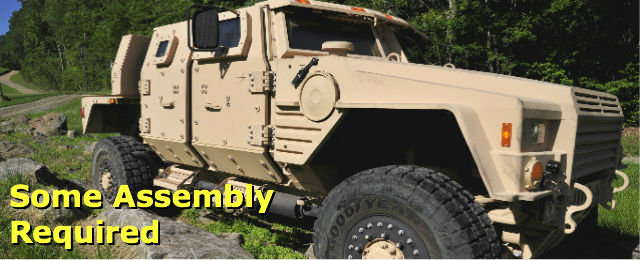Lockheed Camden Team Rolling Out JLTV Prototypes As Contract Decision Nears
by August 4, 2015 4:04 pm 183 views

As the decision gets closer on the contract award for the Joint Light Tactical Vehicle (JLTV) project, Lockheed Martin and rivals Oshkosh Corp. and AM General are making last-minute marketing pitches to win the $30 billion bidding contest to build the next-generation vehicle to protect U.S. Army and Marine Corps ground troops in the future.
On Tuesday, Lockheed announced that it will produce up to eight company-funded prototypes, or Production Representative Vehicles (PRVs), at its Camden production facility – leading up to the Department of Defense expected JLTV award announcement in September.
Lockheed said PRVs are now rolling off the assembly line in South Arkansas in preparation to reduce technical risk, optimize the advanced production processes at the Camden assembly plant, and to exercise and prepare the supply chain.
“The first two of these PRVs are now in Dallas going through a series of tests to validate technical capability and performance,” said Scott Greene, vice president of Ground Vehicles at Lockheed Martin Missiles and Fire Control. “Our goal is to produce the best-value, most protected, most tactically effective JLTV possible to help assure our soldiers and Marines complete their missions and return safely.”
The Lockheed Martin JLTV Team plans to produce as many as eight PRVs over the next few weeks, officials said. “These PRVs are confirming that our processes work just as we knew they would,” stated Greene. “(We) will leave nothing to chance in the production of the JLTV.”
Lockheed officials said the Camden JLTV team is a fully integrated combat tactical system that meets the military’s requirements and was designed with the future in mind. “It offers mine-resistance and ambush levels of protection with unprecedented cross-country mobility, a substantial increase in performance and payload, as well as greater reliability, outstanding fuel efficiency, and lower operations and sustainment costs,” the Bethesda, Maryland-based defense giant said in a statement.
But Lockheed is not alone in trying to making a final impression with U.S. Army and Marine Corps officials who make the decision on what company will build approximately 17,000 JLTVs during the first three years of low-rate initial production, followed by five years of full-rate production.
The Army plans to eventually purchase 49,099 JLTV’s, while the Marine Corps plans to eventually buy 5,500 of the vehicles. For the Army, initial operating capability on the next-generation JLTV is expected in the fourth quarter fiscal 2018.
Last week, Oshkosh Corp. officials said the Wisconsin defense contractor had submitted its final proposed revisions to the Department of Defense for its JLTV program. “Oshkosh’s superior JLTV offering provides next generation mobility and survivability for U.S. troops at a fair value and is ready to enter production today in response to any conflict,” said Oshkosh CEO Charles Szews.
According to the U.S. Army and Marine Corp specifications for the JLTV project, the new vehicle range is expected to offer better protection and survivability from insurgent attacks such as road-side bombings, while also providing a greater payload. The Humvee vehicle that is being replaced, which was built by AM General, was not designed for armored combat or as a patrol vehicle, but nevertheless has been employed as one without much success.
By contrast, the JLTV has been specifically designed for patrol and combat operations. The vehicle family will contain five armored versions including infantry combat vehicles, command vehicles, reconnaissance vehicles, and armored utility vehicles.
